Issues Involved with a Low Birth-rate Society: Focusing on the Increasing Unmarried Population--Young People's Views on Relationships with the Opposite Sex, Marriage, and Children
Currently, the most influential forces behind Japan's declining birth rates are the "tendency to remain unmarried" and the trend towards "married couples having fewer children" 1). This report will focus on the factor of the tendency to remain unmarried. The percentage of children born out of wedlock in Japan is lower than those in Western countries; therefore, the issue of the tendency to remain unmarried is the direct cause of the declining birth rate. Based on the above fact, this article discuss young people's views on relationships with the opposite sex, marriage, and having children in present-day Japan. First, please look at some statistical data. Then the article will introduce a special lecture given by Professor Touko Shirakawa on issues through the life-designing program for university students. Followed by the lecture, a panel discussion was held involving university students and their views on dating, marriage, and having children.
1) Shigeki Matsuda, Declining Birth Rates: Actual Conditions and Causal Factors of Japan's Declining Birth Rates
1. Issues arising from a low birth-rate society, and young people's views and current conditions (by Seiko Mochida, Benesse Educational Research and Development Institute)
First, I will provide statistical data on young people's views and current conditions about dating, marriage and having children. For dating, 60.8% of young men in their early 20s and 46.4% of young women in their early 20s do not have a steady partner (Figure 1). Regarding marriage, about 30% of unmarried young people, both men and women, in their early 20s feel "I don't have to force myself to get married" or "I don't have to get married" (Figure 2). In fact, both the average age of wanting to get married and the average age of getting married are increasing. In Japan where the proportion of children born out of wedlock is low (2.1% in 2008), the average age of having the first child is also increasing, to over 30 in 2012 (Figure 3).
According to the survey results of "2013 Report on People without Children" conducted by the Benesse Educational Research and Development Institute, 55% of unmarried men aged between 25 and 29 and 65% of unmarried women aged between 25 and 29 replied "I definitely want to have children" or "I want to have children if possible", while 45% of unmarried men and 35% of unmarried women replied "I don't care if whether I have children or not," "I don't want to have children," or "I have not thought about having children" (Figure 4), indicating that their views have become polarized. As regards having children, more than 40% of unmarried men and women replied "I worry about the financial burden of having children" (Table 1: the ratio of respondents who replied "True"). In particular, more than 40% of unmarried women replied "True" to the item "My private time will be restricted after having children," or "It must be hard to manage both work and childrearing."
Meanwhile, there are more young people who believe that they should obtain accurate knowledge of pregnancy and childbirth when they are students (Figure 5).
Figure 1. Current conditions of dating
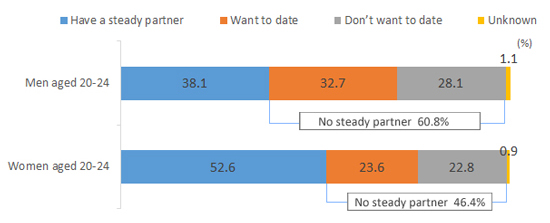
Source: "The Fourteenth Japanese National Fertility Survey in 2010" (Highlights of the Survey Results on Singles) by the National Institute of Population and Social Security Research
Figure 2. Views on marriage
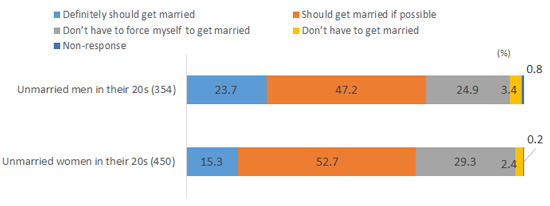
Source: "2014 Survey on Marriage and Family Formation" by the Cabinet Office
Figure 3. Trends in desired age of marriage/age at marriage/age at the birth of the first child
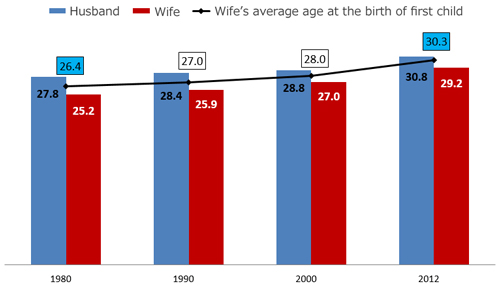

Source: "2014 Declining Birthrate White Paper" by the Statistics and Information Department, Minister's Secretariat, Ministry of Health, Labour and Welfare, Japan
"Annual Population and Social Security Surveys" (The National Fertility Survey) by the National Institute of Population and Social Security Research
Table 1. Views on having children

* Top six answers selected by the respondents out of 13 items
Source: "2013 Report on People without Children" by the Benesse Educational Research and Development Institute
Figure 4. Desire to have children
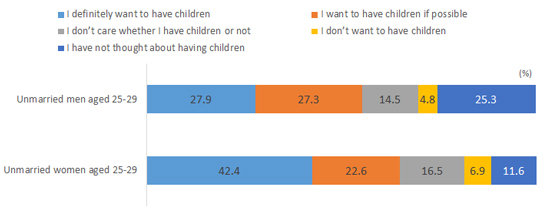
Source: "2013 Report on People without Children" by the Benesse Educational Research and Development Institute
Figure 5. Timing for obtaining medical information on pregnancy and childbirth
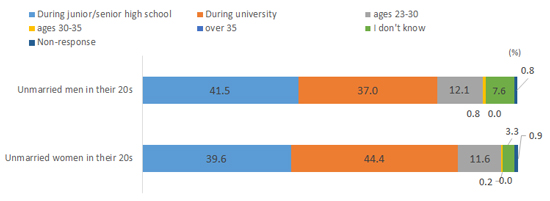
Source: "2014 Survey on Marriage and Family Formation" by the Cabinet Office














